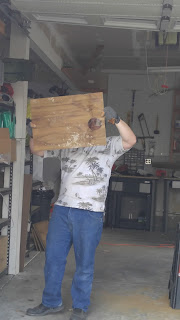This is helpful to the birds who now have a safe place to nest, is fascinating and will keep rodents out of your yard (and your neighbors).
The first step in building an owl box is determining what birds you are hoping to attract. This will depend on what birds live in your area. In our area there are Screech Owls, American Kestrels and Barn Owls. Of these, surprisingly to me, only the Kestrels are endangered. We are hoping to attract Barn Owls as they return to the same place every year, and are less afraid of humans and so will not be bothered by our living in the yard as well.
We would also be happy with Kestrels who are not nocturnal and so we would see more often. Further they appear to need more help than the owls do.
Importantly both of these birds are too small to pose a threat to our puppies, or chickens. Of course you cannot really control what wild animal will decide to live in your owl box, however you can eliminate the risk of larger birds by making the opening and box the appropriate size for the smaller birds. Once you have done your research you can begin.
As usual you start by measuring how much wood you have and determining your plan. We had enough for two boxes which is great as the owlets like to find a place near their original nest to live.
Peter then cut the wood into the boxes, we needed the obvious (left, right, front, back, top and bottom) but also a board to block the entrance from the main part of the box. This requires the animals to go into the box to get to the next, so predators cannot reach in and take out the baby birds.
It is very important to cut the hole in the front of the box to the right size so that the smaller birds you are looking for can get in, but larger ones cannot.
The front also requires roosts for the owls to sit on as they enter. You don't want your roosts to be too large or again predators will also be able to sit on them. By digging ridges into the wood the birds can grip onto the roosts while cats and raccoons will have a harder time.
Once you have done that you also need to drill some holes at an angle for drainage. You are then ready to assemble the box!
In this photo you can see the board that will protect the owlets from anything just reaching in. It is also important to note that the holes in the bottom are angled so that fingers pulling at it will not destroy the box.
One of the sides has an opening so that the box can be cleaned out in the fall when the birds have left for the winter. It is not necessary to do this every fall, but you don't want the box to get too filled up for the next generation to use.
By adding hinges and then turn able L-screws the door becomes something a human can open, but a raccoon would probably have trouble with.
And with that we carefully attach the top, and our box is completed. Once it is a box, it needs to be weather proofed so that it can have years of owls living in it. This is done with a water proof stain and silicon to fill any holes.
Then all that is left is to find a place to mount them. They must be at least 10 feet above the ground. We put one in a shade tree, however most of our trees are fruiting trees, and you don't want to put the box in a tree you will be climbing in to get fruit out of. So the second one is mounted on our back wall. this also makes it harder for other animals to climb up and get to the box.
I'm hopeful that in the next year or so we will have Barn Owls or American Kestrels to observe.


















